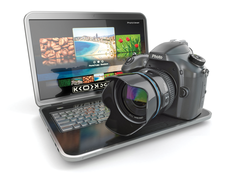Comparing image viewers for photographers
Slide Show

© Lead Image ©maksym yemelyanov, 123RF
For today's photographers, image viewer programs are an essential piece of equipment, because they can help you quickly load and sort your photo and video files. We compare some of the top image viewers.
Imagine you've just returned from vacation and are sitting down to look at pictures from your trip. For anyone who enjoys photography, this can be a daunting task as you find yourself sifting through hundreds, or even thousands, of photos. However, this time-consuming process can go much faster if you use an image viewer rather than RAW developers or database-driven photo collectors, such as Darktable or Lightroom. What you want is an image viewer that can quickly load even high-resolution RAW images from full-frame DSLRs and that can also handle larger image collections.
In the open source universe centered around GNU/Linux, there are numerous candidates for this task, from simple image viewers without further functions up to genuine all-rounders with numerous image processing functions. In this overview, we focus on image viewers in the narrower sense, excluding RAW developers with image databases for managing photos such as Darktable or RawTherapee.
Requirements
An image viewer has one primary task: It has to display images on the screen. It should also be capable of handling exotic formats and loading the pictures at lightning speed. The output of Exif information – such as exposure time, aperture, and focal length – or a map with the position of the shot helps to classify the images.
[...]
Buy this article as PDF
(incl. VAT)
Buy Linux Magazine
Subscribe to our Linux Newsletters
Find Linux and Open Source Jobs
Subscribe to our ADMIN Newsletters
Support Our Work
Linux Magazine content is made possible with support from readers like you. Please consider contributing when you’ve found an article to be beneficial.

News
-
Mozilla Plans to AI-ify Firefox
With a new CEO in control, Mozilla is doubling down on a strategy of trust, all the while leaning into AI.
-
Gnome Says No to AI-Generated Extensions
If you're a developer wanting to create a new Gnome extension, you'd best set aside that AI code generator, because the extension team will have none of that.
-
Parrot OS Switches to KDE Plasma Desktop
Yet another distro is making the move to the KDE Plasma desktop.
-
TUXEDO Announces Gemini 17
TUXEDO Computers has released the fourth generation of its Gemini laptop with plenty of updates.
-
Two New Distros Adopt Enlightenment
MX Moksha and AV Linux 25 join ranks with Bodhi Linux and embrace the Enlightenment desktop.
-
Solus Linux 4.8 Removes Python 2
Solus Linux 4.8 has been released with the latest Linux kernel, updated desktops, and a key removal.
-
Zorin OS 18 Hits over a Million Downloads
If you doubt Linux isn't gaining popularity, you only have to look at Zorin OS's download numbers.
-
TUXEDO Computers Scraps Snapdragon X1E-Based Laptop
Due to issues with a Snapdragon CPU, TUXEDO Computers has cancelled its plans to release a laptop based on this elite hardware.
-
Debian Unleashes Debian Libre Live
Debian Libre Live keeps your machine free of proprietary software.
-
Valve Announces Pending Release of Steam Machine
Shout it to the heavens: Steam Machine, powered by Linux, is set to arrive in 2026.

